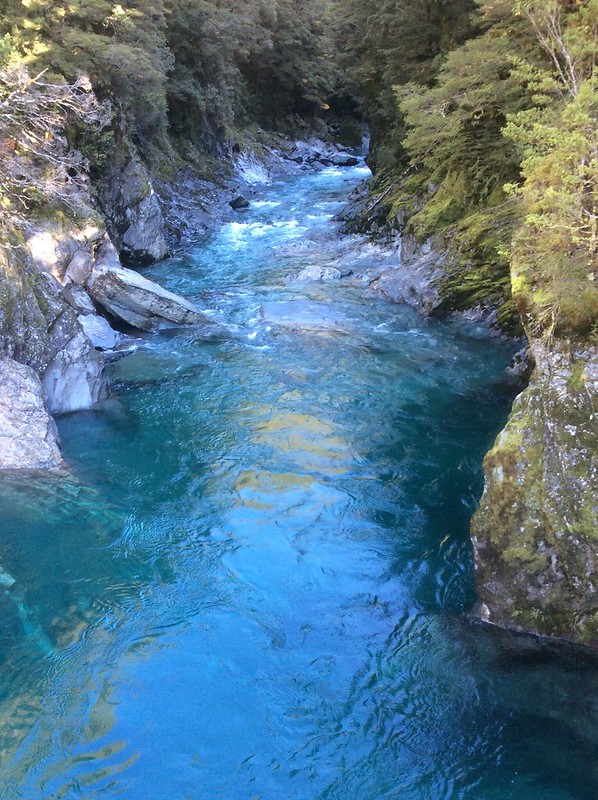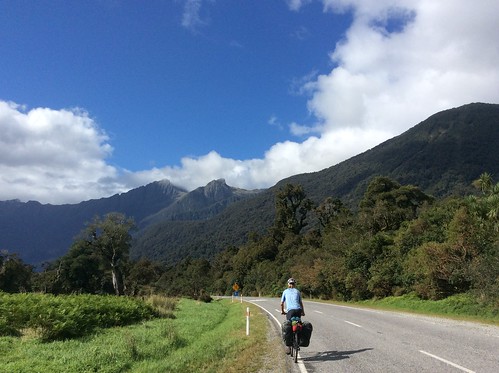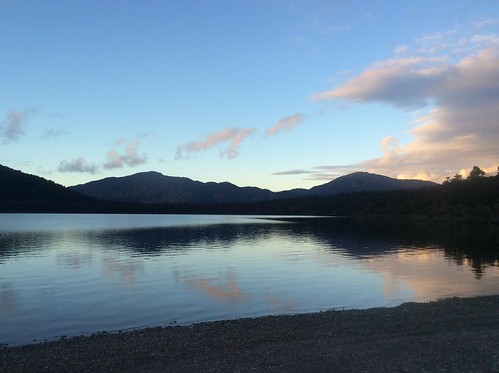"It appears to be a law that you cannot have a deep sympathy with both man and nature."
-Henry David Thoreau
Besides glaciation, Tasmania and the South Island of Aotearoa (New Zealand) have very different geological histories. Because Tasmania is not situated between two tectonic plates its mountains were formed through magma intrusions caused by the splitting up of Gondwana. The cooling of this magma is responsible for the infamous dolarite peaks Tasmania is well known for. These mountains are notably dispersed rather than ranges (one exception is that of the Hazards found on the Freycinet peninsula. These mountains are part of a long range that extends to Victoria on mainland Australia). New Zealand's South Island is situated between the Australian and Pacific tectonic plates. The Southern Alps are formed by the sideways movement of these plates, which results in a distinct mountain range.
 |
| Some of the Southern Alps found in Mt. Aspiring National Park |
This difference in mountain peak patterns between the two islands is obvious to most anyone traveling overland, but arguably more obvious to anyone traveling without a motor. The roads are much more up and down in Tassie as there is no avoiding the mountains -they're everywhere and part of the charm. Mountain ranges, on the other hand, are localized. There is much more rolling and flat road in the South Island of New Zealand until you want to switch sides of the range. Unless you're passed out from a night of drinking on a KiwiE bus (a popular mode of travel for the foreign young ones and a thing to avoid around these parts) these geographical contrasts are hard to miss. Something that is less apparent to what seems like a large proportion of visitors here in the South Island is the impact their having on the land, the locals and the future of tourism in Aotearoa. The selfies, the Instagraming, the non-stop use of social media to prove that indeed they have reached the same day hike or lookout point that hundreds and thousands of others have deemed a "must see" has an explosive effect on tourism and a deteriorating affect on the environment.
 |
| View from the Crown Range -the highest paved road in NZ |
 |
| Paparoa NP |
 |
| Pancake rocks with Paparoa NP in background |
 |
| Pancake rocks |
The NZ government is not doing itself any favours by facilitating such behaviour. The South Island makes up most of the country's land mass and New Zealand is poor compared to Australia. Being that Tasmania is situated on the Australian plate, the island is a state of Australia, a grand economy. These geographic differences that influence economic differences are, what I think, the basis for why Tassie's tourism industry exceeds that of Aotearoa's South Island. To be fair, New Zealand's tourism exploded in a relatively short time frame, but they have a lot of land to play with and a less dense population compared to that of Tassie's. The economic situation in New Zealand and perhaps the political will is what I am considering responsible for the inferior infrastructure put in place for tourism in the South Island. Instead of spending precious and limited resources (especially limited compared to Tassie) on informative signs that explains the flora, fauna and history of the lookout you've reached, a helpful sign pointing out the perfect spot for an Instagram shot to add to the hundreds and thousands of other Instagram shots of the exact same thing is posted in big bold colours. Have we reached the point that we cannot recognize a beautiful enough spot to take a photo? The NZ government is promoting its beauty through social media. Better yet, their using the individual tourists themselves to promote key spots on social media. Brilliant. NZ needs money, this will do the trick! Apparently the government thought of constructing a road through Kahurangi National Park in order to create a circuit that would make what is now a relatively remote and inaccessible area to camper vans and buses, yet another jam-packed highway full of them. One newspaper article claimed there were over 60,000 camper vans in New Zealand this summer alone. Locals in the south west refer to campervanners as "maggots" -they're white, they're numerous and they're everywhere. With limited parking, a reputation for freedom camping everywhere, hardly any information presented on site to discourage disrespecting the environment and promoting a select few spots to check out, I think policies need to change before inviting another 60,000 campervanners into the country.
 |
| Instagram hotspot |
 |
| Blue pools. A well known tourist spot along the Haast pass |
This experience has lead me to understand the impact social media can have on tourism. Although apparent before, seeing the result in such an abrupt manner restrained my ability to share even the simplest photo of a place I've enjoyed in New Zealand with friends and family through the social media networks I am signed-up with. The negative impact on the environment and local people has made me and others step back and question whether we should continue to advertise these beautiful places and therefore promote them as worthy and perhaps "must-see" place in the eyes of our audiences -big or small. I had the pleasure of becoming friends with the author of Toothbrush for Nomads. A lovely travel writer who has seen success in her blog and also seen the consequences of such success. Toothbrush for Nomads brought people around the world to beautiful and interesting places that were often considered "off the beaten path" or "off the tourist trail". The author realized that if she were to continue to promote these places they would no longer be off the beaten anything and they would become yet another tourist attraction complete with selfie sticks and, heaven forbid, Instagram hotspot signs. Sadly, you can no longer read the inspiring words that were once published alongside stunning photos on the Toothbrush for Nomads blog. The author decided to take the blog offline. A noble move especially considering how successful it had become.
 |
| Biking along the Haast pass |
 |
| Lake Paringa. Another tourist spot. |
 |
| One of many glacier fed rivers near Fox glacier |
I have avoided the crowds (so to speak) on the Internet and wish not to seek any fame. However, should good writers who have a passion for travel blogging and spreading the good word of the kinds of beauty this world has to offer be morally obligated to stop pursuing these honerable goals? Can not humanity work together on a more sustainable system that enables the rich and the poor to trot the globe, see new things and at the same time gain a better appreciation for our planet? I've learned a new word recently while reading Ramon Bolívar's text "O sentido tellúrico da humildade":
Telluric
Of the earth as a planet.
Or
Of the soil.
I did not read the text in Portuguese, I had google translate the text to English. Although a rough translation, the impact was successful. Bolívar explains that humans are truly humble only once they realize their telluric nature. If more of us could realize our telluric nature, then human activities such as travel could be harmonious with our environment. Until that day maybe we need more travel bloggers following in the humble footsteps of Toothbrush for Nomads and take a step back. Realize the real impact you are having on people and that that impact is what encourages people to travel to the "off the tourist trail" place you are writing about and the consequences that come with this movement. The NZ government would do well to take a step back with you.
